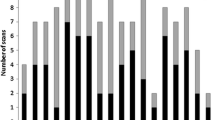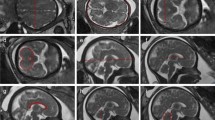Abstract
Introduction
Prenatal magnetic resonance (MR) imaging is currently used to measure quantitative data concerning brain structural development. At present, morphometric MR imaging studies have been focused mostly on the third trimester of gestational age. However, in many countries, because of legal restriction on abortion timing, the majority of MR imaging fetal examination has to be carried out during the last part of the second trimester of pregnancy (i.e., before the 24th week of gestation). Accurate and reliable normative data of the brain between 20 and 24 weeks of gestation is not available. This report provides easy and practical parametric support to assess those normative data.
Materials and methods
From a database of 1,200 fetal MR imaging studies, we retrospectively selected 84 studies of the brain of fetuses aged 20–24 weeks of gestation that resulted normal on clinical and radiological follow-up. Fetuses with proved or suspected infections, twin pregnancy, and fetuses of mothers affected by pathology that might have influenced fetal growth were excluded. Linear biometrical measurements of the main cerebral structures were obtained by three experienced pediatric neuroradiologists.
Results
A substantial interobserver agreement for each measurements was reached, and normative data with median, maximum, and minimum value were obtained for brain structures.
Conclusion
The knowledge of a range of normality and interindividual variability of linear biometrical values for the developing brain between 20th and 24th weeks of gestation may be valuable in assessing normal brain development in clinical settings.

















Similar content being viewed by others
References
Kubik-Huch RA, Huisman TA, Wisser J et al (2000) Ultrafast MR imaging of the fetus. AJR Am J Roentgenol 174(6):1599–1606 Jun
Bekker MN, van Vugt JM (2001) The role of magnetic resonance imaging in prenatal diagnosis of fetal anomalies. Eur J Obstet Gynecol Reprod Biol 96(2):173–178 Jun
Breysem L, Bosmans H, Dymarkowski S et al (2003) The value of fast MR imaging as an adjunct to ultrasound in prenatal diagnosis. Eur Radiol 13(7):1538–1548 Jul
Levine D, Barnes PD, Robertson RR et al (2003) Fast MR imaging of central nervous system abnormalities. Radiology 229(1):51–61 Oct
Frates MC, Kumar AJ, Benson CB et al (2004) Fetal anomalies: comparison of MR imaging and US for diagnosis. Radiology 232(2):398–404 Aug
Whitby EH, Paley MN, Sprigg A et al (2004) Comparison of ultrasound and magnetic resonance imaging in 100 singleton pregnancies with suspected brain abnormalities. BJOG 111(8):784–792 Aug
Garel C, Chantrel E, Elmaleh M et al (2003) Fetal MRI: normal gestational landmarks for cerebral biometry, gyration and myelination. Childs Nerv Syst 19(7–8):422–425 Aug
Garel C (2005) Fetal cerebral biometry: normal parenchymal findings and ventricular size. Eur Radiol 15:809–813
Watanabe Y, Abe S, Takagi K et al (2005) Evolution of subarachnoid space in normal fetuses using magnetic resonance imaging. Prenat Diag 25:1217–1222
Twickler DM, Reichel T, McIntire DD et al (2002) Fetal central nervous system ventricle and cisterna magna measurements by magnetic resonance imaging. Am J Obstet Gynecol 187:927–931
Levine D, Hatabu H, Gaa J et al (1996) Fetal anatomy revealed with fast MR sequences. AJR Am J Roentgenol 167:905–908 October
Prayer D, Kasprian G, Krampl E et al (2006) MRI of normal fetal brain development. Eur J Radiol 57:199–216
Claude I, Daire JL, Sebag G (2004) Fetal brain MRI: segmentation and biometric analysis of the posterior fossa. IEEE Trans Biomed Eng 51(4):617–626 Apr
Guibaud L (2004) Practical approach to prenatal posterior fossa abnormalities using MRI. Pediatr Radiol 34:700–711
Garel C (2004) MRI of the fetal brain. Springer, Berlin, p 29
Stazzone MM, Hubbard AM, Bilaniuk LT et al (2000) Ultrafast MR imaging of the normal posterior fossa in fetuses. AJR Am J Roentgenol 175:835–839 September
Rados M, Judas M, Kostovic I (2006) In vitro MRI of brain development. Eur J Radiol 57:187–198
Hertzberg BS, Kliewer MA, Freed KS et al (1997) Third ventricle: size and appearance in normal fetuses through gestation. Radiology 203(3):641–644
Amin RS, Nikolaidis P, Kawashima A et al (1999) Normal anatomy of the fetus at MR imaging. Radiographics 19:S201–S214
Zalel Y, Seidman DS, Brandt N et al (2002) The development of the fetal vermis: an in-utero sonographic evaluation. Ultrasound Obstet Gynecol 19:136–139
Triulzi F, Parazzini C, Righini A (2005) MRI of fetal and neonatal cerebellar development. Semin Fetal Neonatal Med 10:411–420
Chong BW, Babcook CJ, Pang D, Ellis WG (1997) A magnetic resonance template for normal cerebellar development in the human fetus. Neurosurgery 41(4):924–929 Oct
Malinger G, Zakut H (1993) The corpus callosum: normal fetal development as shown by transvaginal sonography. AJR Am J Roentgenol 161:1041–1043
Garel C, Brisse H, Sebag G et al (1998) Magnetic resonance imaging of the fetus. Pediatr Radiol 28:201–211
Conflict of interest statement
We declare that we have no conflict of interest.
Author information
Authors and Affiliations
Corresponding author
Rights and permissions
About this article
Cite this article
Parazzini, C., Righini, A., Rustico, M. et al. Prenatal magnetic resonance imaging: brain normal linear biometric values below 24 gestational weeks. Neuroradiology 50, 877–883 (2008). https://doi.org/10.1007/s00234-008-0421-7
Received:
Accepted:
Published:
Issue Date:
DOI: https://doi.org/10.1007/s00234-008-0421-7




